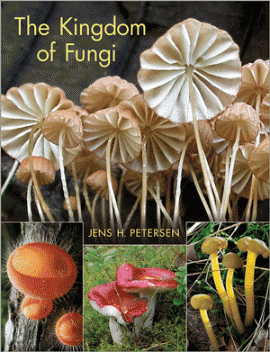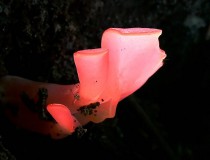Learning fungi
It’s hard to learn about fungi. And eww, why would you want to? Aren’t they all either diabolical molds or poisonous mushrooms? Of course not. Fungi are an amazingly old and diverse kingdom, yet hardly anyone knows much about them, even us mycologists. After all, we think that we’ve only even given names to about 5 to 10% of them. Not a typo.
So let’s say your interest is piqued— you want to know more. Good for you. You could go the mushroom route: join a club, attend forays, eat stuff, and learn from eclectic mushroom gurus. Yes, do that, it is fun, you will learn interesting things, and it will give you a window on some of the wonders of fungi. But most fungi –the vast majority of them– are not mushrooms. At some point you will start to wonder about all the rest.
 Here is where most people get stuck. How do you begin to learn about the incredible variety of fungi? How they are related to one another; how they live? If you can even find one, you could take a college course: you’ll learn the secrets of fungi, capture them, and observe them up close and personal. Do that, excellent, but it’s not for everyone. You may hurt your brain or your wallet. If you are very brave, skip the class and get hold of a mycology textbook. You will fall asleep more quickly at night, because although the texts are good, they are dense, use lots of terminology, and are not so pleasingly illustrated. You might skip the textbooks and read some of the growing number of books that explore the stories of fungi, that is good too, yes! do that. Yet, if you are a visual learner, the emphasis on text over images may make you wish for more.
Here is where most people get stuck. How do you begin to learn about the incredible variety of fungi? How they are related to one another; how they live? If you can even find one, you could take a college course: you’ll learn the secrets of fungi, capture them, and observe them up close and personal. Do that, excellent, but it’s not for everyone. You may hurt your brain or your wallet. If you are very brave, skip the class and get hold of a mycology textbook. You will fall asleep more quickly at night, because although the texts are good, they are dense, use lots of terminology, and are not so pleasingly illustrated. You might skip the textbooks and read some of the growing number of books that explore the stories of fungi, that is good too, yes! do that. Yet, if you are a visual learner, the emphasis on text over images may make you wish for more.
So do this: buy Jens Petersen’s book, The Kingdom of Fungi. Sadly, I haven’t met Dr. Petersen, but he is clearly very cool, and adventurously knowledgeable, and very adept with a camera. He’s created the missing piece, a joyful photo-essay on the glorious diversity of fungi. It will not hurt your brain or your wallet. Because of all the beautiful photos, you will hardly even notice you are learning things, that you are developing a structured view of the kingdom of fungi. As a teacher, I find that this structure gives us a comfortable place to put future learnings. That is, if you know a little about the kinds of fungi, you will have an easier time predicting the qualities of some fungus you’ve just encountered for the first time. His classification scheme is refreshingly modern; his pages are beautifully laid out. His photos of itty bitty fungi will (finally) convince you of the beauty and intricacy of smaller landscapes, and you may even find yourself wishing for a hand lens.
 Fungi are cool, but they are foreign to us, and hard to get a grip on. So this question comes up a lot — how do I learn more about fungi? Here is a book for you and me. Not too much text, not much jargon. Enough order to help you build a scaffolding for your growing understanding. And lovely photographs to please anybody–over 800 of them in just 265 pages (have a look inside). There’s even an unknown fungus, the Amazonian mystery tongue, which is sticking its tongue out at us all, as fungi often do. I’m so happy to see this book, it makes for a great start in fungi.
Fungi are cool, but they are foreign to us, and hard to get a grip on. So this question comes up a lot — how do I learn more about fungi? Here is a book for you and me. Not too much text, not much jargon. Enough order to help you build a scaffolding for your growing understanding. And lovely photographs to please anybody–over 800 of them in just 265 pages (have a look inside). There’s even an unknown fungus, the Amazonian mystery tongue, which is sticking its tongue out at us all, as fungi often do. I’m so happy to see this book, it makes for a great start in fungi.
Wishing you a happy journey and much joy in your fungal education.
Here is some juicy extra stuff for you.
- For a limited time, you can listen to Jens Petersen (genius, see above), along with Lynne Boddy (fungus professor/genius) and Phil Ross (fungus artist/genius) via the BBC radio program, The Forum. I enjoyed this show, and note that Lynne and the host (UK) say fun-ghee. Jens and Phil (Denmark, US) try to say fun-ghee but seem to lapse into alternate pronunciations: fung-eye and sometimes fun-j-eye. In much of the US and Canada we say fun-j-eye with a soft J sound. Take your pick.
- Interview with Jens H. Petersen by Pedro Crous. IMA Fungus, 4(1) June 2013, pp. 21-22(2). Open Access download.
- Here is Dr. Jens H. Petersen’s website of fungal photographs. You can also find him via MycoKey, an innovative website that aims to help you identify fungi from around the world.
The image of the Amazonian mystery tongue is by Jens Petersen, and you will find its intriguing tale at the end of his book.


THANKs for posting this Kathie! i just looked at the pages of the book on the blog website. Beautiful! I will definitely put this on my list.
Kathie,
This book is fabulous. I ordered it after reading your recommendation, and am spending the holiday weekend transfixed by the photos, and learning so much. Thank you, and best wished for a joyous and fungi-filled New Year.